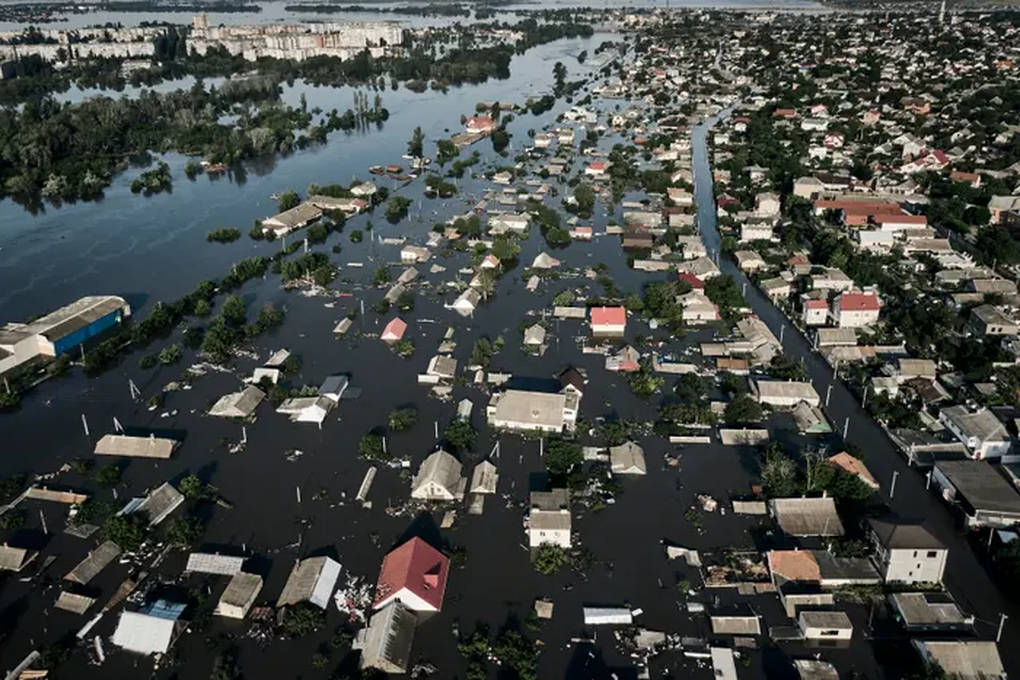(Dan Tri) – The collapse of the giant hydroelectric dam on the Dnieper (or Dnipro) River is overshadowing the picture of Ukraine’s long-awaited counterattack.
The Kakhovka dam collapse caused serious flooding downstream of the Dnieper River, Kherson, Southern Ukraine (Photo: Maxar).
Obstructing Ukraine’s counterattack campaign
The collapse of the strategic Kakhovka dam in Kherson province, southern Ukraine on June 6 is raising questions about its impact on the future situation of the Russia-Ukraine conflict.
Analysts said the dam collapse occurred just as Ukraine was preparing to launch a counterattack.
Ben Barry, a senior fellow at the International Institute for Strategic Studies, said: `Remembering that Russia is on the strategic defensive and Ukraine is on the strategic offensive, in the short term it’s certainly a
Maciej Matysiak, a security expert at the Stratpoints Foundation, said that floodwaters entering the area will prevent the deployment of heavy weapons, such as tanks, for at least a month.
`This creates a very good defensive position for the Russians,` Mr. Matysiak said.
Kiev and Moscow are blaming each other for the Kakhovka dam collapse even though neither side has provided specific evidence.
Marina Miron, a researcher at King’s College in London, called this a turning point in the conflict.
`For the Russians, the reason to do that was obviously to prevent a Ukrainian counter-offensive and create a humanitarian situation in Kherson where people needed to be evacuated, as well as create swamps to prevent the troops from being attacked.
For Ukraine, the dam collapse could be a way to distract the Russians while Kiev counterattacks, she added.
Meanwhile, Patricia Lewis, director of International Security Studies at Chatham House, said the situation favored Russia even if Ukraine launched a counterattack soon after.
The strategic hydroelectric dam in Kherson collapsed (Video: Twitter).
Ecological and environmental disaster
As flood levels continue to rise, officials and analysts are beginning to calculate the human and environmental toll on Ukraine, one of the world’s most fertile agricultural nations.
At least 150 tons of motor oil from the dam leaked into the Dnieper, and environmental damage was estimated at 50 million euros ($53.8 million), Ukrainian Environment Minister Ruslan Strilets told a news conference.
Floods have submerged villages and towns around the city of Kherson, while Russian officials warn that the main canal supplying water to the Russian-annexed Crimea peninsula is receiving less water.

A large area in Kherson was flooded with floodwater (Photo: AP).
The dam’s vast reservoir also supplies cooling water to Europe’s largest nuclear power plant in Russian-controlled Zaporizhia.
However, for the environment and agricultural sector of Ukraine, one of the world’s largest grain exporters, the damage could be severe, and it would put further strain on global supply chains following the
`The impact caused by flooding will last not just for weeks or months, but for a long time,` Mr. Strilets said.
The challenge is that this is a very large dam, one of the largest reservoirs in the world, said Mohammad Heidarzadeh, a civil engineer at the University of Bath in England.
Modupe Jimoh, professor of Civil and Humanitarian Engineering at the University of Warwick, predicted that the dam collapse would release industrial chemicals and lubricants into the soil and groundwater, damaging the ecosystem and
Mr. Strilets said that rare wildlife species downstream are in danger.
Ukrainian Foreign Minister Dmytro Kuleba accused Russia of destroying the ecosystem, and the floods would cause irreversible harm.
However, Russia denied responsibility and accused Ukraine of sabotaging the dam to distort military failures.

Location of the Kakhovka nuclear power plant and hydroelectric dam (Graphic: Reuters).
